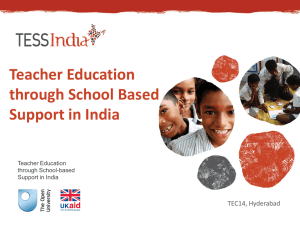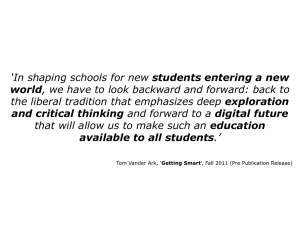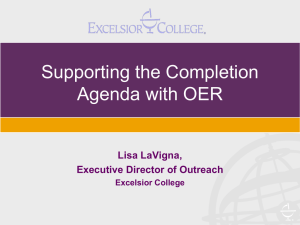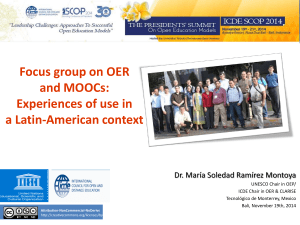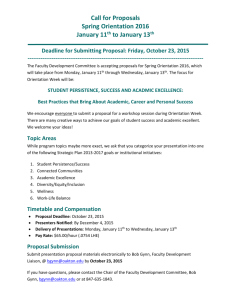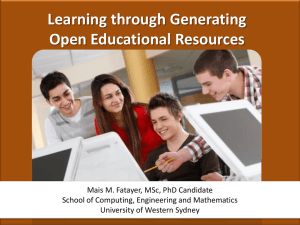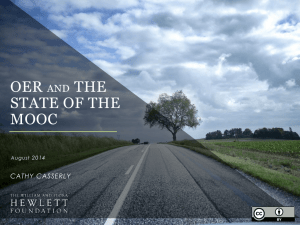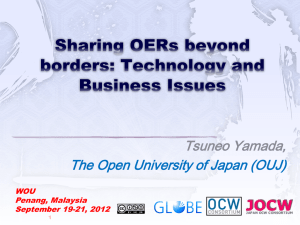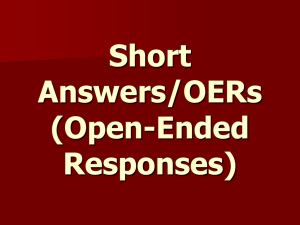Microsoft Word
advertisement
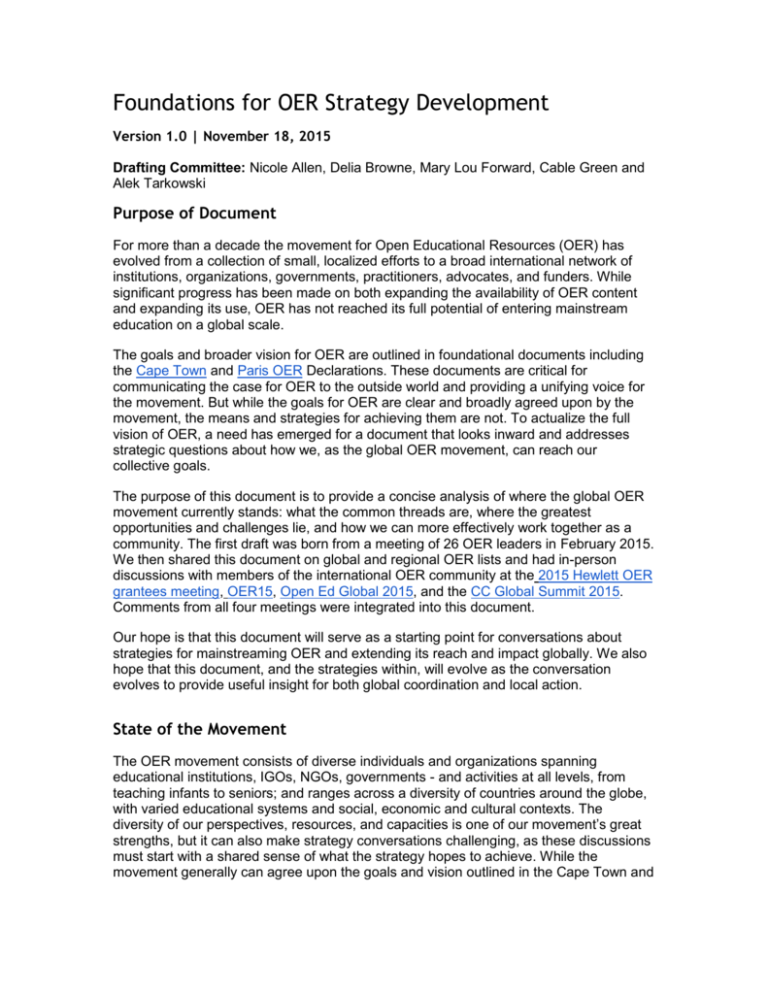
Foundations for OER Strategy Development Version 1.0 | November 18, 2015 Drafting Committee: Nicole Allen, Delia Browne, Mary Lou Forward, Cable Green and Alek Tarkowski Purpose of Document For more than a decade the movement for Open Educational Resources (OER) has evolved from a collection of small, localized efforts to a broad international network of institutions, organizations, governments, practitioners, advocates, and funders. While significant progress has been made on both expanding the availability of OER content and expanding its use, OER has not reached its full potential of entering mainstream education on a global scale. The goals and broader vision for OER are outlined in foundational documents including the Cape Town and Paris OER Declarations. These documents are critical for communicating the case for OER to the outside world and providing a unifying voice for the movement. But while the goals for OER are clear and broadly agreed upon by the movement, the means and strategies for achieving them are not. To actualize the full vision of OER, a need has emerged for a document that looks inward and addresses strategic questions about how we, as the global OER movement, can reach our collective goals. The purpose of this document is to provide a concise analysis of where the global OER movement currently stands: what the common threads are, where the greatest opportunities and challenges lie, and how we can more effectively work together as a community. The first draft was born from a meeting of 26 OER leaders in February 2015. We then shared this document on global and regional OER lists and had in-person discussions with members of the international OER community at the 2015 Hewlett OER grantees meeting, OER15, Open Ed Global 2015, and the CC Global Summit 2015. Comments from all four meetings were integrated into this document. Our hope is that this document will serve as a starting point for conversations about strategies for mainstreaming OER and extending its reach and impact globally. We also hope that this document, and the strategies within, will evolve as the conversation evolves to provide useful insight for both global coordination and local action. State of the Movement The OER movement consists of diverse individuals and organizations spanning educational institutions, IGOs, NGOs, governments - and activities at all levels, from teaching infants to seniors; and ranges across a diversity of countries around the globe, with varied educational systems and social, economic and cultural contexts. The diversity of our perspectives, resources, and capacities is one of our movement’s great strengths, but it can also make strategy conversations challenging, as these discussions must start with a shared sense of what the strategy hopes to achieve. While the movement generally can agree upon the goals and vision outlined in the Cape Town and Paris Declarations, the specific missions and priorities of community members vary widely. The common thread that seems to unite the movement is the need to expand the adoption of OER. While there are different visions for the specific practices, impacts, and audiences to be served and supported by expanding OER, we can all generally agree on what OER is, and that widespread use of OER is a positive and meaningful change in education. Given this common understanding, strategies can grow out of identifying the common challenges and opportunities around OER, and developing a shared sense of priority about what kind of actions will help advance the proliferation of OER development and use. We Have Similar Perspectives On... Definition of OER: The movement broadly agrees on the definition of OER as put forth by the William and Flora Hewlett Foundation or UNESCO, noting that there may be some differences around which specific open licenses qualify as OER (such as those restricting commercial use). However, the general understanding that OER must be both free (no cost) for anyone to access and to legally modify (according to the 5R activities: retain, reuse, revise, remix, redistribute) is widely accepted. Overall Vision: The Cape Town and Paris Declarations each outline aspirational visions and goals for actualizing the potential of OER. While community members may prioritize some elements over others, in general the movement agrees that these documents form the basis for what we hope to accomplish. Necessity of OER Adoption: While members of the community hold different goals for OER use, and different perspectives on the aspects of OER that are most important, we are united in asserting that OER adoption is necessary to actualize its potential. We understand adoption as a two-step process: people adopting OER instead of non-open resources, and people taking advantage of the rights and permissions granted by OER, to use and reuse content. OER Ecosystem: We also agree that as preconditions of OER adoption, three elements are necessary: o Users: Awareness of OER and the motivation to use it. o Content: OER content that users want - and the tools to find, use, and adapt it. o Context: Community and systemic support that will sustain OER. General Value Proposition: OER makes education accessible and expands the universe of what’s possible in education. Licensing Standard: There is general recognition that Creative Commons licenses (excluding those with an ND restriction) are the standard way to license content as OER, where licensing is required. We Have Various Perspectives On... Most Important Strategic Goals of OER There are many strategic goals for OER, and while we generally agree that all of them are important, members of the movement place priority on different aspects. Some of the most typical strategic goals of OER are: Reducing barriers to education, including access, cost, language and format. Enabling the free access to and reuse of expressions of human knowledge, in all of its forms. Ensuring educators have the legal rights to retain, reuse, revise, remix and redistribute educational resources as they determine - without having to ask permission. Increasing the efficiency and effectiveness of public funds spent on education. Transforming teaching and learning and enabling effective, open pedagogy. Connecting communities of educators and learners around open content. Expanding the use of internet and digital technologies in education. Enhancing educational opportunities to foster development and more productive, free societies. Empowering educators to have more agency in the classroom. Extent of OER Adoption Necessary to Consider the Movement a “Success” There are varied opinions about what extent of OER adoption is necessary for our model to achieve success: Disrupting the educational materials and services market so that it flips to OER as the default model for resource production. Shifting public funding models to pay for publishing, distribution and adoption services, rather than paying for individual copies of textbooks. Sufficient quantity of high quality, curated OER necessary to provide users choice. Mainstreaming OER among educators so it competes with the traditional publishing model in terms of reach and use. Entire degree programs replace commercial textbooks with OER. Significant number of education and training systems built with curriculum based on OER. New pedagogical approaches enabled by the 5R permissions of OER demonstrate superior learning outcomes and become popular among faculty. Measurable increase in learning achievement that leads to employability. Top Strategic Priorities for OER Taking into account the strategic goals listed above, we can define several leading actions to achieve them. While the movement can agree that all of these actions are important, there is no consensus on which one is the top priority. Some of the top priorities are: Build OER content to fill gaps in key disciplines or contexts and enable productive reuse, including openly licensed ancillary materials (slides, assessment items, etc.) and openly licensed competency maps and lists of learning outcomes. Develop and implement open licensing policies that require public and foundation funded educational resources are openly licensed by default. Create and communicate effective research studies in conjunction with OER development and use. Grow and foster communities that support, in a grassroots manner, the development and mainstreaming of OER. Develop models or strategies for OER adoption, development and/or evaluation that can be replicated in other contexts. Build key tools that enable more effective development, management, discovery and reuse of OER. Broaden our focus to include the practices of educators and learners that can be achieved with a shift to open resources, for example, open pedagogy, open educational practices, open assessment, open credentials, etc. Better communicate the value of OER to educators, policy makers and other key constituencies. Scale OER in a specific sector, i.e. primary and secondary (K-12), tertiary (higher) education, workforce development, lifelong learning, etc. Movement Strengths The OER movement has achieved multiple victories and successes. Among the most important ones are: Breadth of Content: Over years, different projects have tested and developed a wide range of open resources that are high quality, cost-effective, effective in supporting learning, and sustainable. Resources include OER repositories and referatories, textbooks, and courses. Resources span all levels of education from early childhood to adult, and cover manifold topics and subject areas. Strong Policy Models: Successful OER advocacy has led to the design and deployment of policies supporting OER production and use, at different levels: school, city, national and international. Policies have also been developed by private educational foundations and private companies. Together, they provide a broad template that can be adapted and reused. Collective Impact: Coalitions have been proven to be successful in promoting OER, advocating for open licensing policies, and achieving change. They provide for a strong legitimization by a collective voice of varied actors with an interest in education: NGOs, public institutions and individual advocates. Growing Ties with the Open Movement: OER activism as part of a broader open movement is benefitting from growing ties with advocates of open science, open data, open access publishing, free and open source software, open culture, and open government. For example, students and young researchers think about OER and Open Access (OA) together; librarians with good understanding of OA are a growing force supporting OER; and OER policies are strengthened by including them in broader open government policies. Individual Champions: Significant successes in OER are often attributed to passionate, persevering champions, particularly in the policy and adoption arenas. Such individuals are able to achieve significant change almost singlehandedly. They’re especially important when their experience and knowledge can be multiplied, by building collaborations, mentorship models, and networks with other activists. Global Reach and Significance: OER has been recognised by key international organizations active in education, and has support at institutions across the globe. Supportive Research: Key projects and scholars have been conducting research on OER and its impacts, and the breadth and depth of this research continues to grow. Movement Challenges Challenges include both external (conditions in the greater educational environment) and internal (issues within the OER movement). Not all challenges are present in every national or local context, but many themes arise frequently in strategy conversations, including: Linear Rate of Growth: Momentum is building, but adoptions are still primarily happening on a one-by-one basis, and we’re still piloting and proving one example at a time. While pilots often prove successful, the models rarely end up being replicated or brought to scale. For full impact to be realized, growth needs to be exponential rather than linear, both within national contexts and internationally. Lack of Consistent Models: Other movements in the "open" space have developed commonly understood models for implementation. For example there are the so-called "green" and "gold" routes to Open Access: self-archiving published articles in a repository and publishing directly in an OA journal. While the details differ between contexts, these two pathways are generally applicable across most countries, institutions and sectors. Given the variance between countries, educational systems, and sectors, it is unclear whether developing standard models is possible in the OER space. However, it has significantly increased the opportunities for international collaboration and resource development in parallel open movements, and an absence of commonly understood pathways could be a barrier slowing us down. Insufficient Awareness: Awareness of OER is still very low. This is true both in terms of understanding that OER exists as an alternative to currently used materials, and a deeper understanding of the benefits, quality, and potential innovations that can happen when it is adopted. While awareness is not a sufficient (or in some cases, even necessary) condition for adoption, it is a common barrier faced toward achieving the benefits of OER. Difficulty of Discovery, Use and Remix: OER discovery, curation and reuse are often laborious and complicated. This is a consistent challenge across the commons. Repositories are varied and do not have shared search terms and metadata. Materials are presented in a wide variety of formats. Tools to assist with reuse, curation and remix are insufficient, not well known, and/or are not themselves open. Inconsistent Breadth and Depth: OER supply is uneven across subject areas and disciplines. Some OER is very complete, while others are little more than links or shells. This can undermine the impacts of awareness raising and slow down momentum if people who want to adopt OER don’t have OER to adopt. Lack of Evidence: A persistent area of frustration for OER supporters is the lack of compelling, locally-relevant evidence for the impact of OER. This includes research demonstrating efficacy and illustrative case studies. Just as important is a better understanding of contextual variables that affect OER adoption and impact, such as educator practices, and the ways resources and IT are employed in education. Questions About Sustainability: Business models, public funding models for supporting OER continue to develop, with numerous case studies of each. However, there are still questions surrounding long-term sustainability and the ability for OER to “stick” in the marketplace without philanthropic support. Minimal Evidence of Reuse: Potential for reuse is one of the key arguments OER advocates use to promote their model; using OER can make teachers and students into active creators and collaborators, while resources become dynamic and improve over time. Yet we don’t have enough compelling testimonials, case studies or evidence that this is taking place, nor have we connected this advantage to a broader problem that stakeholders care about. Cultural and legal barriers can also stand in the way. Reliance on Textbooks. Textbooks have traditionally been the primary mode of course material adoption, and many faculty, teachers, and schools remain focused on finding a single resource that meets all of their needs. This limits the potential for OER adoption, as educators are often not equipped to consider assembling a textbook or course pack from multiple sources, let alone moving beyond the textbook. Poor Branding: In recent years, the term “open” is used in education ever more widely, with a variety of meanings. It gives opportunity to bring OER into a broader educational debate - but with several definitions of “open”, educators and learners are understandably confused. We are at risk of others “openwashing” OER. At the same time, paradoxically, the term OER is little known, difficult and technical - not a perfect educational “buzzword”. Perfect as an Enemy of the Good: It is critical to maintain a strong definition of OER to avoid “openwashing,” but this can also create a dynamic where efforts that take a step in the right direction, but do not meet our definition, are excluded and not given recognition. Lack of OER heroes: Mainstreaming OER requires stories that make people pay attention - exciting and engaging enough to make them interested in a relatively challenging subject that combines content, people, pedagogy, technology and law. We have good stories, but not great ones. Some of the really big stories in modern, digital education, such as Khan Academy and MOOCs, are at best ambivalent about open. Opportunities Many opportunities exist for advancing OER, both in new ways and by expanding on opportunities that have already proven successful. We have organized the opportunities below based on the three components necessary for OER adoption: users (awareness of and motivation to use OER), content (OER and tools to use them), and context (community and systemic support for sustainability). These opportunities identify key places where the movement can intervene to help advance OER, and are intended to provide a useful starting point for developing strategies. Users Increase Awareness: It is essential to raise awareness of OER as an option, both as an alternative to proprietary materials (and publishers’ new lease-notown models) and also in new markets underserved by traditional publishers. Also, there is a significant awareness opportunity within populations already using openly licensed materials without fully realizing that they are using OER or that they can exercise 5R rights. Build Evidence Base: Improve the body of evidence showing the positive impacts of OER, focusing on contexts where OER presents an especially critical solution to a problem. This includes efficacy research that looks at key areas such as improved learning outcomes, business models, innovative reuse, improving equity, and cost savings. It also includes compelling case studies and stories that illustrate positive impacts. Improve Communications: Build a stronger case for OER to strengthen its branding and value proposition. Be more active in communicating by developing resources, coordinating messages, and working with other segments of the open movement. Consider the key target audiences of OER, and tailor resources to reach those audiences. Assets such as compelling human stories, infographics, and plain language resources will be key. Embed OER In the Teaching Profession: Take advantage of ready-made pathways for professors and teachers to become aware of and learn to effectively use OER. In the short term, this could be linking OER with professional development activities that educational systems already conduct. In the long term, this would be integrating OER into teacher training and preparatory programs. Engage Key Constituencies: OER adoption is not just about engaging the teachers, education institutions and policymakers who make resource decisions. Other constituencies, particularly librarians and students, can play a key role in helping to catalyze and support these decision makers in learning about and shifting to OER. Librarians are experts at finding, curating and sharing resources. This community wasn’t originally deeply engaged in OER, but has increasingly become involved. Students are also key as the beneficiaries of education, and also the largest constituency in terms of numbers. Students can also be mobilized to raise awareness and as a catalyst for action. Other key constituencies include copyright officers, accessibility services, bookstores, financial aid, instructional technology, and instructional designers. Empower the grassroots: Without grassroots support from educators, OER policies will never fulfill their potential. In particular, the promise of reuse cannot be met without the engagement of users with open resources. Coordinate Demand With Supply: Focus on building demand in areas where supply exists. Content Build OER That Educators Want to Adopt: To reach the mainstream, it is important to build OER that meet the needs and expectations of educators. For educators accustomed to traditional materials, this often means "turnkey" resources that are ready to use and convenient to adopt. For educators looking to expand the way they teach, this may be easily remixable, adaptable, interoperable resources that can be easily tailored and shared with students. The specifics may vary by context, but a greater focus what educators want can help OER adoption spread on a faster and wider scale. Once practitioners are using OER in a familiar form, more work can be done to support their exploration of innovative remixing and use. Develop Strategic Tools: While building tools alone is not enough to solve problems, there are some central challenges that can be removed through strategic, interoperable tools to support the OER lifecycle: development, curation, discoverability and 5Rs activities. The most immediate need to support adoption is tools for the effective discoverability of OER, but we also need tools that enable users to fulfill the promise of OER in terms of creation, open licensing, reusing, remixing and sharing their work with other teachers and students. Build Supply to Meet Demand: The OER movement has learned that the “build it and they will come” philosophy is not often successful. It is more effective to prioritize building OER in areas where educators need and are asking for well developed, curated OER. "Building supply to meet demand" could mean something like finding 25 colleges and universities that want to adopt Nursing OER in place of expensive, proprietary textbooks and curriculum, and then building those OER with them. Given government and civil society goals for education to lead to living-wage jobs, the OER community ought also partner with universities, colleges and schools to build OER-based academic programmes that make more people employable. Accessibility: The flexibility offered by the 5Rs offers significant advantages over traditional materials in making content accessible for students with disabilities. OER can be built more easily to conform to universal design for learning (UDL) principles, and existing OER can be adapted and altered to meet accessibility needs without the legal and technical limitations typically placed on traditionally published materials. This is an area where OER can naturally lead the way. Develop OER For Tomorrow: As OER gains momentum, there are increasing signs that traditional textbook publishers will cede areas of educational content to OER and shift to selling new types of products, such as access to learning analytics or customized learning pathway platforms. While this is a sign of progress, it is also a potential pathway to the same problems we face with traditional content today. To ensure a more open future for education, the OER community needs to build both OER and open learning pathways and analytics platforms to support the future learning needs of students and data needs of educators. Open Up Existing Platforms and Resources: Evangelizing open can help turn existing services and resources into OER. This is a key, alternative tactic to creating new, open resources. This allows our movement to benefit from already existing resources, networks and communities, once they are openly licensed. Learners as Creators: Inherent in open pedagogies and open educational practices is the idea of students as creators. If harnessed effectively, engaging students in the development, improvement and assessment of content could help drive the adoption and revision of existing and the production of new OER. Context International Growth: Successful OER projects tend to have a relatively small scale and have not widely spread to other institutions, regions, or countries. Using key projects as models for scaling is a major opportunity for our movement. At the international level, it is important to build foundations of the OER movement by examining local needs and priorities, and then using and adapting best practices, advice and tools from existing projects and experiences. National Mainstreaming: Multiple projects prove sustainability and benefits of OER, but OER has still not entered the mainstream at a global scale. In countries with relatively developed OER activities, a key opportunity is to shift from a narrow OER community to the broad education community, by addressing broader values and needs of educators. It is crucial to develop, at national level, an integrated set of activities that combines policy work, content production and curation, and community building into a holistic model for OER growth. Institutionalization: The long term sustainability of OER depends on education institutions becoming not only the creators and users of OER, but also the support systems behind it. Efforts to embed OER in teacher training, professional development, student orientation, information literacy, tenure and promotion, and other relevant institutional processes will help build this capacity. Open as an Aspect of Digital in Education: The Paris Declaration describes OER as an aspect and key element of digital education. OER can be successfully introduced if merged with IT in education initiatives - and vice-versa: digital education strategies are more sound, effective and sustainable if they include OER. For example, adopting OER can free up funds for the purchase of digital devices for students. Government Funding: Governments are the largest potential source for funding that can bring OER to scale. In many cases they are already spending money directly on course materials, textbooks, or on programs that create educational materials. We need strategies such as open license funding requirements (e.g., Creative Commons licenses) that will redirect some or all of that money to OER. Publicly funded educational resources should be openly licensed by default. It is also important to educate both government staff and recipients of government funds about open license requirements, how to properly mark works to receive appropriate attribution, to create and share editable files (e.g., not PDF) so the public can revise and remix, and where to submit finished OER. Improve Movement-Wide Coordination: Members of the movement are doing effective, impactful work, but there is a lack of coordination between segments of the movement that may have similar or complementary aims. Increasing communication and coordination among groups within the movement can help accelerate progress through shared best practices, improve efficiency by avoiding duplication of efforts, and amplify impact by identifying areas of synergy and common messages. This could take the shape of a lateral network that connects various nodes; not a top-down or time-intensive requirement. The goal is not to stop people from doing good work, but rather to ensure that the work being done is amplified and built upon for better service to the movement as a whole. Connect With Other Open Movements: Movements for openness in research publishing, science, data, software, and other areas are pursuing similar goals and are facing similar challenges. While some areas of OER are beginning to forge ties, a more deliberate effort to coordinate messages and actions will help build a stronger and broader open movement that benefits us all. To the extent possible under law, http://oerstrategy.org has waived all copyright and related or neighboring rights to Foundations of OER Strategy Development. This work is published from: United States

